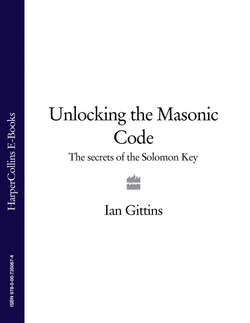Читать книгу Unlocking the Masonic Code: The Secrets of the Solomon Key - Ian Gittins - Страница 15
The origins of the term Freemason
ОглавлениеThere is no agreed absolute etymological derivation of the term Freemason but, rather, two competing theories. Medieval construction workers were divided into the labourers who cut the hard stones from the quarries (known as Rough Masons) and the skilled workmen who shaped the softer, more malleable rock known as free stone. These workers became known as Free Stone Masons, later shortened to Freemasons. A simpler explanation is that these Masons, freed from regular employment, were able to travel around the country looking for work, and thus were genuinely Free Masons.
by creating their own stonemasons’ trade guilds.
Part-educational college, part-fledgling trade union, these guilds were initially illegal and their members forced to convene in secret. Their dual goals were to train up future Master Masons in the skills of designing and erecting vast cathedrals, while at the same time zealously guarding the knowledge and tricks of the trade that enabled them to do so. To this end, members were given signs (passwords) and grips (handshakes) by which they could identify fellow Masons before sharing crucial information with them.
Furthermore, the guilds operated on a strictly hierarchical basis. Students admitted to the fraternity, who were often as young as twelve, were schooled both in theory and on the job by Master Masons. As these Masons continued their training they were allowed privileges along the way, such as the right to carve their own identifying ‘mark’ into some cathedral stones.
However, even the most gifted student was highly unlikely to become a Master Mason in less than ten years. Were he to divulge even the most minor trade secret to an outsider, he would be instantly banished from the guild and ostracized by all Master Masons.
As Church and State became aware of the existence of stonemasons’ guilds, there were attempts to legislate them out of existence. In 1360, King Edward III passed a law banning all secret Masonic pledges and societies, and sixty-five years later the Regency Government forbade Masons to gather in numbers in any circumstances. This law was soon deemed unworkable and was rarely applied.
The twelfth to fourteenth centuries saw Freemasons scale new heights of influence and importance. As Gothic cathedrals sprang up across Europe, their services were in sharp demand. Masons rebuilt Canterbury Cathedral along Gothic lines in 1174 after its eastern wing was destroyed by fire. However, Wells Cathedral, where construction work began in 1180, is generally regarded as the first major English cathedral built entirely in the Gothic style.
Westminster Abbey, York Minster, Ely Cathedral and Winchester Cathedral all had Gothic devices added to their existing edifices, and across the Channel in France imposing structures arose at Notre-Dame in Paris, Chartres, Amiens and Rouen. Unsurprisingly, the Catholic Church also built cathedrals nearer to home, in Milan, Florence and Siena, as well as across the Low Countries and Spain.
Yet despite their elevated social and occupational status, Freemasons were largely far from venal and self-serving. The stonemasons’ guilds may have been formed partly to protect their members’ business interests, but these bodies also strove to inculcate high standards of moral and personal behaviour amongst practitioners of the trade. Various rules, or ‘Charges’, urged Masons to render their own lives as noble and upright as the cathedrals they built—not a concern that you can imagine troubling the labour unions of today.
